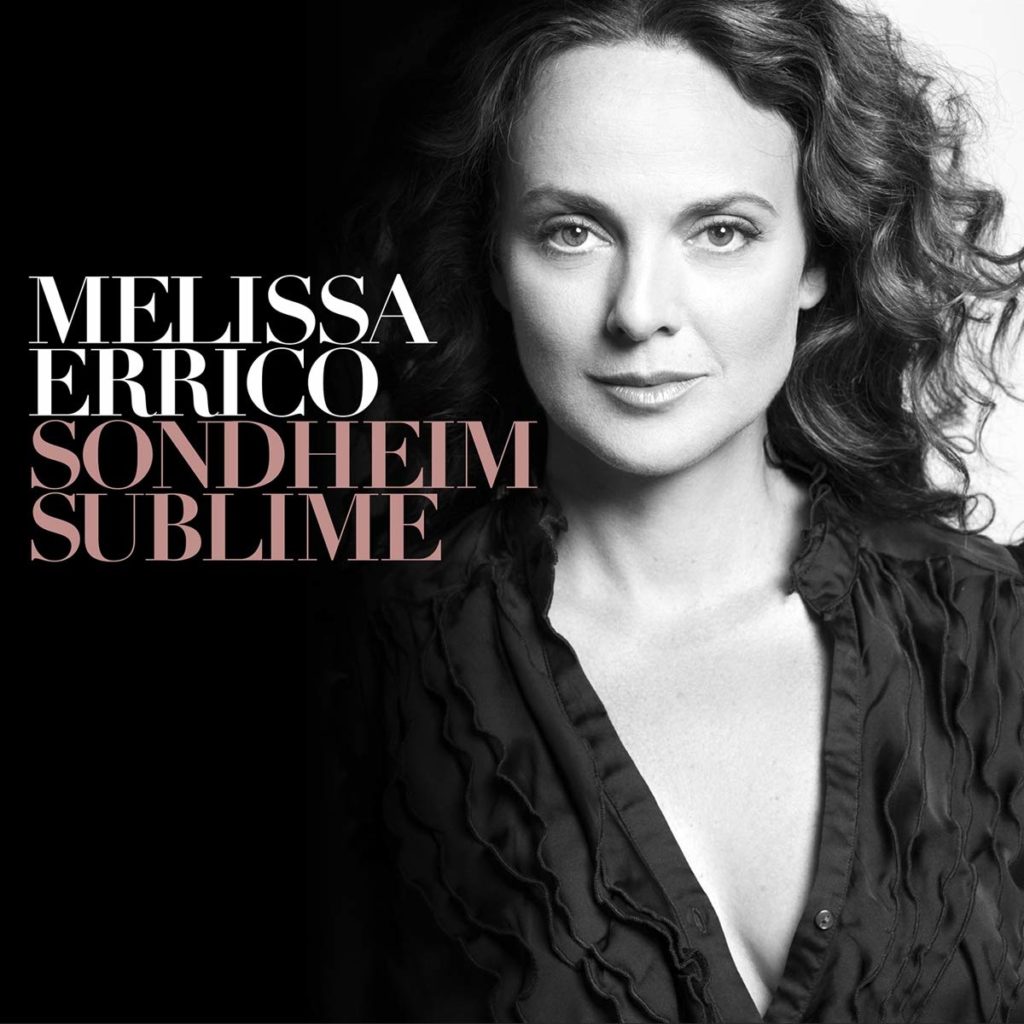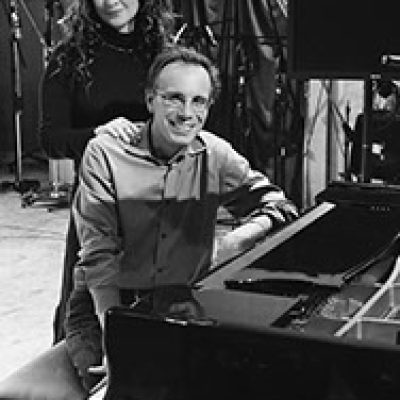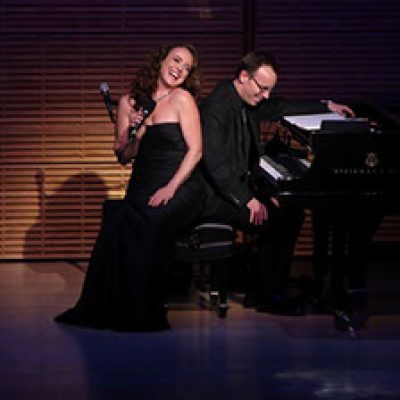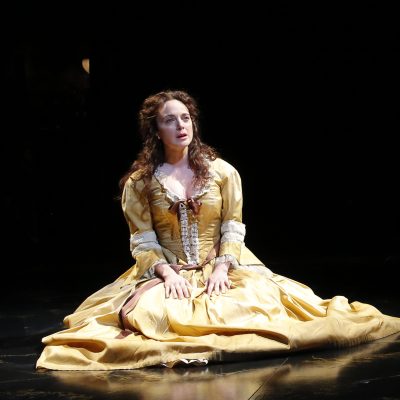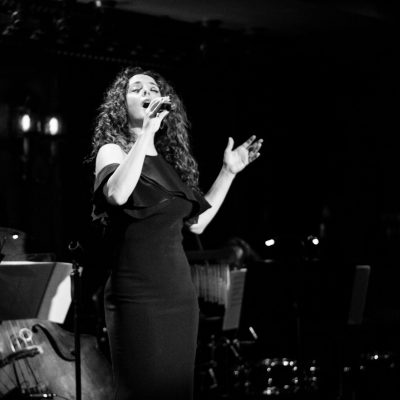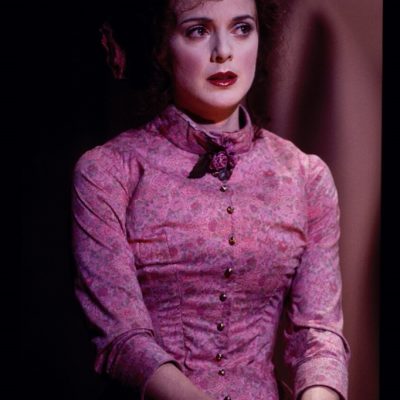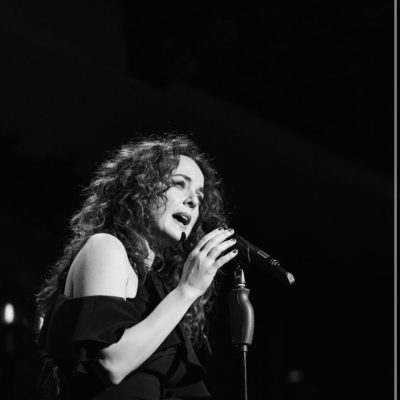—The Wall Street Journal
Liner Notes by Melissa errico
The first time I sang for Stephen Sondheim I was in the bath. Raul Esparza and I were doing Sunday in The Park with George at the Kennedy Center, and I played Dot, who is a painter’s model to the greatest of dot-makers, Georges Seurat. I had been an art history major in college and, excited to be living in a pointillist painting, I had had an idea: to replace the makeup table (where the character of Dot is getting all primped and prepped for a date night with her busy painter beau) with a bathtub, where I would sing nude in bubbles, on stage. There were a lot more nudes in baths in impressionist painting than there were makeup tables. My concept was that Dot’s nudity would be unashamed and might even accent the rejection when Georges chooses to cancel their date-night in order to finish that damn hat.
At the time, I had no idea that this was… Sondheim and you weren’t supposed to suggest changes quite this freely. I don’t know if he was impressed by my audacity or sympathetic with my naiveté. But he sweetly embraced the idea, to the point that he even ended up obliging with a few new lyrics that suited a bathing Dot better than a primping one.
Since then I like to think that a certain watchful half-smile has always inflected our work together. Not too long ago, I was at the dress rehearsal for the Encores production of Do I Hear a Waltz? and all of us were called to the stage very formally– would cast and crew please go to the stage! And there he was— like Balanchine— surrounded as if by a flock of birds— with 75 people looking his way. I couldn’t see quite, and I climbed onto the set behind him, a Venetian balcony, dressed as my lonely character, Leona, and I saw him there. His profile in front of an eager crowd. All breathing shallowly. I bent over the railing, and said “Hello!” And he looked up and smiled and said “Ah! You were wonderful— most of the time.”
I knew at once what he had done! The quicksilver pause. The legendary Sondheim caesura, the bittersweet comma, the way that in all of his greatest songs an emotion gets expressed… and then gets qualified, made a little rueful, just a touch unsure. One emotion happens— and then its opposite. You’re grateful— and you’re sorry. There ought to be clowns. Well, maybe next year. Marry me, a little. We had a good thing going, going, gone. (You see it on his face. Always turned into a comma, always that space where we stop to reflect on our emotions even while we are having them.) It’s what makes him so wonderful to sing— most of the time.
Having danced around his caesuras for a couple of years in the cabarets and concerts that preceded this album, for the recording itself I decided to choose only the most cosmic of his commas, big songs balanced on major emotions. Move on or stay still? Grow or stop? Even, live or die? But all still balancing-act songs, about choices. (And those interspersed with a few lighter moments, as with “Sooner or Later” where the choice is less live and die and more like love, or sigh.)
— Melissa Errico
Track Listing
- Sooner or Later
- Loving You
- I Remember
- No More
- The Miller’s Son
- Losing My Mind
- Send in the Clowns
- Not While I’m Around
- Not a Day Goes By/Marry Me a Little
- Children Will Listen
- Isn’t He Something!
- Move On
- Goodbye for Now
- With so Little to Be Sure Of
- Children and Art
Liner Notes by Adam Gopnik
The first time I heard Melissa Errico sing was in a musical theater workshop. She was singing a song of mine, actually, a tricky, highly multi-syllabic song that David Shire and I had written, in which a former dancer applied the vocabulary of ballet steps to the ‘everyday dance’ of her current life as a working mother, a song that had exasperated or defeated several other fine singers. Melissa began to sing, to act the song – and suddenly, the song was alive. The ambivalence that had troubled or baffled or annoyed other actresses – that the character both loved her family and work and her mastery of it, and yet still had longings for a richer life of fulfillment and even of erotic adventure, at the same time and even in the same moment – was somehow fully achieved by her, and in an instant’s performance. Singing perfectly all the while. She was passionate and comic, maternal and enraged, loving and longing in equal parts and in quick succession, all by gentle inflections and adjustments of voice and glance and movement, while still landing every odd rushed syllable and pun – and every terrifying David Shire incidental sharp and flat – exactly right, all in perfect diction and with a voice like a Mozart clarinet. If there was a secret to it, I realized when she did it again, even better, an hour or so later, it was that instead of trying to mark ambivalence by suggesting two things at once, she marked it by being many things in a seamless sequence: first wry, then longing, then self-mocking, then graceful. One emotion shaded into the next so well that they seemed to be all there at the same time. An entire person was there, who I knew already – I had based the lyric on my dancing wife’s dazzling life — now offered in perfect pitch in a gorgeous warm voice with immaculate diction, immaculately sung, and every ambivalence evident.
‘She’s fantastic! “I whispered to the director, who nodded dutifully. Like anyone in the theater, he already knew.
Since then many collaborations, on songs and shows – and in her own new form of talking-singing cabaret that she jokingly dubs the ‘caber-essay’ – has done nothing to alter the firmness of that verdict. And it was inevitable, I knew, that she would someday tackle ambivalences and exaltations far more accomplished than anything I could offer – that she would climb the highest and steepest mountain of mixed emotions in all of modern music, the songs of Stephen Sondheim.
Employing a unique mix of smartness and soulfulness – analytic intelligence enlisted to deliver unimpeded emotion – Errico’s mastery, like all mastery, is grounded, one learns over time, in an attention to detail, a willingness to break the work down into its smallest parts in order to build it up again into the one right whole. She approaches each Sondheim song as an actor approaches a soliloquy – with each verb, each noun, considered line by line, then sewn together.
Word by word exploration of a lyric, note by note inquiry into a melody – she once dazzled a Lincoln Center audience by showing that the rarely- heard verse to “Over the Rainbow”, which tells us in advance where Dorothy is going, entirely alters the meaning of the song and how it must be sung, since it becomes less discovery than description. A writer herself, she is a gift to any writer, inasmuch as she will explore all of the background books that touch on any role she’s playing. And she can be a strong reader. “Don’t write the song in the scene,” she will sweetly implore a hapless script, or “book” writer who has done that, meaning not to anticipate in dialogue what the number itself will deliver, since any song that works on stage has to become a scene in itself. The rigor of her analysis empowers her. She can take the coy Rodgers and Hammerstein “I Cain’t Say No” and, by the subtlest twists of phrasing and tempo and tone, turn it into a proto-Follies ballad of a melancholy and exploited girl. (“The word ‘light’ is as important to find in Sondheim as the word ‘love’ is in Sinatra,” she said once, casually and significantly, to a singing student.)
These are the smarts. The soulfulness rises from sources more mysterious and manifold, from an entire emotional self – though one small secret, which she sometimes shares, is that she often sings a song for someone very particular: husband, or children or friend or, sometimes, a long-discarded beau. The effect is universal, but the address is, for the singer, as intimate and particular as it sounds. Singing to the world, or in a crowded, cutlery-clattering supper club, she always sounds as though she’s speaking to one person alone.
Though the old album form of the two-sided record is long vanished, the idea that a record works best in two groupings of six or seven songs each, is a strong one, and still evident here. For this recording is divided into rough halves that together might be said to be all about love’s lessons – the first half devoted to the loves, the second to its lessons. The album starts with a beautiful juxtaposition of two kinds of passion, each one perfectly landed. “Sooner or Later”, originally written as a kind of mock-man-hunting song in the 1990 movie Dick Tracy, becomes a number of pure enticement – mischief recollected in tranquility, as Wordsworth didn’t quite say. But then “Loving You”, from 1994’s Passion, becomes a song of pure longing, stripped even of libido. In the original show a slightly terrifying and even psychotic song of obsession, a plain woman addicted to a beautiful man, in Errico’s version it becomes a song about self-annihilating love, of the kind that we all know at some moment in our lives: “Loving you is not a choice—it’s who I am.” This first ‘side’ climaxes with a shattering version of one of Sondheim’s greatest (and most tellingly Gershwinesque) arias, “Losing My Mind”, from 1971’s Follies. A song that can lead a singer into a trap of melodrama and ‘big’ gestures, Errico makes it confidential, an understated announcement: in the middle of an ordinary morning, a woman shares the simple truth that her sanity may not survive her pain.
The second ‘side’, of lessons and teaching, begins with “Not While I’m Around”, a song of fanatic devotion from the scary 1979 ballad opera Sweeney Todd, which Errico, at full warmth, and backed by a lovely, addictive arrangement, universalizes into a song of enclosure and protection for all the endangered children of the world. “Send in The Clowns”, by now a bit of an elegiac chestnut, becomes in her version once again witty, rueful, and above all specific: it’s an actor’s song, rooted in an actresses’ knowledge of entrances and exits and make believe. And, though the big and moving Sondheim is here in all its glory – “No More” and “Move On” – one might feel a special affection for a couple of smaller songs. “Goodbye for Now”, another movie song, from 1981’s Reds, becomes, in Errico’s handling, at once. childlike in its trustfulness – See I free you, and I’ll see you when I see you, Fine, ok? – and mature in its wisdom that true love can sometimes be the accommodation of a contradiction. (The photographer Richard Avedon loved this song, and made it the anthem of his love affair with a distant Parisienne.) The grouping of lessons ends with very early Sondheim, 1964’s “With So Little to Be Sure Of” – and here she does admit openly that she’s singing for her incomparable accompanist throughout this adventure, the great pianist Tedd Firth. As Bill Evans did for Tony Bennett, or Ellis Larkins for Ella Fitzgerald, his jazz mastery provides a gently italicizing ease that offsets and never competes with Errico’s essentially dramatic and theatrical style.
For Errico is, by nature, a hyper expressive performer, who transmits emotion powerfully because she takes in emotion so fully – and sometimes transmits with so much poetry because she feels with so much pain. (She has sometimes ruefully referenced Randy Newman’s “Real Emotional Girl” as her ‘anthem’.) For all his eloquence, there is always something cool and hidden, haunted, in Sondheim’s work – so the emotional charge and intimate urgency of Errico’s singing gives a warmth and intensity to even his wryest moments, a burnish to his bronze. The contradiction between Sondheim’s reticence and control, and Errico’s confessional intensity, makes for something better than might be achieved by either sensibility uncrossed by the other.
It’s one more contradiction – one more comma, as she would say– to balance an album on. But then, what’s a great singer for except to find us a balance between the sublime power of music and the beautiful precision of words, between seductive sound and specific sense? What’s anyone’s art, ever, but an ambivalence achieved?
– Adam Gopnik
